Your basket is empty
Already have an account? Log in to check out faster.
Already have an account? Log in to check out faster.

Cacio e Pepe is a delicious pasta, no doubt about it. A favorite of chefs and home cooks, its shortlist of ingredients makes simplicity forefront. With simple recipes, the quality of ingredients becomes even more important since there are "fewer flavors" to hide the dish behind.
I was very fortunate that the first kitchen I worked at in NYC was focused on seasonal Roman Italian style cooking, and each dish was hyper-focused on a primary ingredient and making that ingredient shine. The fact is though, there was no hiding a mistake and honestly, I made a few (lots) of them until I finally understood the ingredients and the technique of simplicity. Fundamentally, quality ingredients lead to quality food and don't get in the way by overdoing it.
There is a technique to this sauce that you'll want to pay attention to. Pasta water, friction, and "cooking" the pasta a little bit in the pan BEFORE the cheese gets added. As pasta cooks, it releases starch into the water making the water more viscous. This is also true with allowing the pasta to finish its last little bit of cooking time (right before your target al dente) in the sauce, which releases more starch into the sauce directly and allows the dish to become well "emulsified". You do have to add a splash or two more of the pasta water to the pan when you do this, otherwise, it's just slightly undercooked noodles sitting in warm butter. When ready, the friction of stirring and tossing helps the cheese easily melt into the already smooth & creamy sauce.
Since there is a shortlist of ingredients, let's delve a little more into each one. Just as a side note, a well-stocked larder should have these in it and it also makes for a super quick and easy dinner. Each ingredient suggested brings its own unique flavors and tastes that when combined become more than the parts. Of course, you can substitute to suit your preferences in flavor and texture.
Tellicherry black pepper is very tasty and provides a depth of flavor that balances well with the peppers' "spiciness".
Pecorino Romano is a hard, salty cheese made from sheep milk in Lazio.
Parmigiano-Reggiano that is aged 18 to 24 months. This slightly dryer, slightly sharper king of cheeses and can melt into a sauce without becoming stringy (and is also great for snacking on while waiting for the water to boil).
European style (unsalted) butter tends to be a little fattier and slightly aged while providing a richer flavor and mouthfeel.
Extra virgin olive oil that you would use to dress a salad or drizzle as a finishing oil. It should be well balanced in flavor and texture.
A NOTE ABOUT AUTHENTICITY
I’ve suggested ingredients in this recipe which strictly speaking, aren’t used in truly authentic Cacio e Pepe. If you’re looking for an authentic version of this dish omit the oil, butter and parmesan. You’ll want to reread the note about the technique of using pasta water and starch to create the base of a sauce, which is the real secret to the recipe. If that step isn’t flawless though, the cheese can easily clump, and the dish may not be quite as good as you hope. On the flavor profile, this will yield a sharper & intense dish and the pecorino Romano you select will be front and center (so get the good stuff).
Be the first to hear about recipes, sales, and new offerings.
0 comments